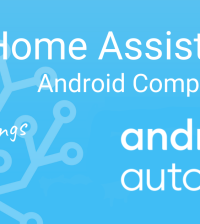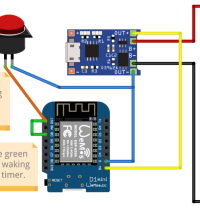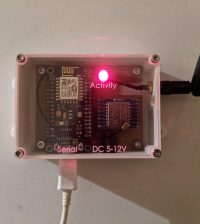- makeITcircular 2024 content launched – Part of Maker Faire Rome 2024Posted 2 weeks ago
- Application For Maker Faire Rome 2024: Deadline June 20thPosted 2 months ago
- Building a 3D Digital Clock with ArduinoPosted 7 months ago
- Creating a controller for Minecraft with realistic body movements using ArduinoPosted 7 months ago
- Snowflake with ArduinoPosted 8 months ago
- Holographic Christmas TreePosted 8 months ago
- Segstick: Build Your Own Self-Balancing Vehicle in Just 2 Days with ArduinoPosted 8 months ago
- ZSWatch: An Open-Source Smartwatch Project Based on the Zephyr Operating SystemPosted 9 months ago
- What is IoT and which devices to usePosted 9 months ago
- Maker Faire Rome Unveils Thrilling “Padel Smash Future” Pavilion for Sports EnthusiastsPosted 10 months ago
LIGHTS CONTROL THROUGH GESTURE

The Tactigon is a board for wearable applications prototyping, able to recognize gestures and different kind of movements, thanks to the firmware availability and simple programming which are typical of the Arduino environment. You knew about it
In the introductory post published issue and in the first proposed application; now you can see it in another capacity by combining it with Raspberry Pi board.
In a project born from the need of lights controlling in an environment. For this domotics application, we relied on the excellent performance of the “raspberry” board to interact with the intelligent board THE TACTIGONTM, in order to control the lights in our office with a few simple.
The connection between the two units is done via Bluetooth Low Energy radio protocol and it’s made possible thanks to the integrated radio chip in both devices and to THE TACTIGONTM libraries made available by Next Industries.
In the Raspberry Pi 3 we used BlueZ, with enabled experimental featured, in order to use Bluetooth Low Energy, as well as bluepy library for python.
THE PROJECT
Let’s go further into details and see how the system is composed; Raspberry Pi 3 is the “brain” of the application ang THE TACTIGONTM is the input device; we needed an actuator that physically interacted with the electrical circuit of the lights to be controlled and we found it in a board with 4 relays, whose status is set with the same number of logical levels as the number of TTL inputs of the device.
Relays are equipped with the exchangeable to switch electrical loads operating through voltage, so able to manage light bulbs working at 230 Vca; for each one, a LED on board is expected (located nearby) that signals current status by lighting when the relay is energized and by turning off in the opposite case.
In our application we decided to control the 4 relays in such a way as to guarantee – in the 2 environments where this system will be installed – two brightness levels; this will be achieved by lacing two lighting bodies for the environment and by turning on only one of them or both for each local area. More exactly, we can turn on one of the two lighting bodies (configuration side A), the other (configuration side B) or both, that means leaving the lights off.
Each relay controls a ceiling light (two relays per room…) and the control is based on the gesture identified THE TACTIGONTM board. shows which realys are activated by basing on the orientation of the board, that is, to the corresponding gesture. To easily make gestures with your hand, THE TACTIGONTM boards can be applied to a glove.

– Correspondence between the orientation of The Tactigon and the activation of the relays
As a recap, components used in this project are;
Raspberry Pi 3 Model B board;
THE TACTIGONTM board;
4-channels relay board;
jumper cables.
The glove to place THE TACTIGONTM must be added to this, useful to avoid entering in contact with the electric circuit; and this is needed not because of a risk problem, but because the body’s resistance would alter proper functioning. The resistance would, in fact, be inserted among various points of the circuit that should not be connected. Next Industries (https://thetactigon.com) is developing a special glove for THE TACTIGONTM that will soon be available.
CONNECTIONS
Let’s see now how to implement the application, starting from hardware parts; the 4-channels relay module was connected through a jumper to the Raspberry Pi single board computer 3, of which we have used pins 7, 11, 13 e 15 to provide the command signal to the inputs of the relay, while pins 4 and 6 are used to pick up the necessary 5V to the board and the GND line, which is the common mass power supply and control signals.
The wiring of all necessary parts is shown in the picture, where you can see which pins of the expansion connector of the Raspberry Pi have to be connected to the relay board.

The output terminals of the relay board allow lamps connection, which has to be done by interrupting the wire that carries the phase to the lighting bodies and by making it pass from the relays exchange, that’s between C and NO (normally open). Remember that the connection to the lamps must be made with an electric cable with a suitable section and with suitable insulation as required to work with the
230 Vca of the electric grid; you must also pay due attention and take care of the insulation, keeping in mind that the pitches of the board relating to the relays and to the terminal blocks will be subject to the grid voltage. We, therefore, recommend to enclose the 4-channels relay board in a plastic box, that will isolate both the board and the connections to the terminal blocks, thus preventing accidental contact and dangerous short circuits. By the way, if you want to perform a preliminary test of the whole, be sure that the floor on which you lay the circuits is made of insulating material (for example a wooden or laminated ant or melamine table).
Note that since THE TACTIGONTM is a board mainly created to make mobile applications, you must necessarily power it with battery in order to make it work applied to the hand; for this purpose, we suggest to use a lithium component (for example LiPo) equipped with a cable ending with a connector (female) with a 2,54 mm pitch to be inserted in the male one of the board. Battery must be 3,7V and about 150÷200 mAh capacity.
THE APPLICATION
Let’s analyze what we did to let TACTIGONTM and Raspberry PI 3 communicate via wireless interface Bluetooth Low Energy.

The protocol
We begin by describing the communication protocol established for communication between TACTIGONTM and Raspberry Pi, which is very simple: two bytes are sent (it is possible to send up to 20 bytes in a package, for more complex protocols), with these features (byte values are hexadecimal):
0x0088: it activates the relays in order to switch on the lamps of side A only;
0x5A5A: it activates the relays in order to switch on the lamps of side B only;
0x00BB: it activates all the relays (it lights all lamps);
0x1515: it deactivates all the relays (it turns off all lamps).
INSTALLATION OF THE NECESSARY MODULES AND LIBRARIES
We can conclude the discussion on the hardware and switch to the software, in order to see how to prepare and program the Raspberry Pi. Here, or, better, in the system microSD-Card, the Raspbian Stretch operating system must be installed, it was released at the end of November 2017. The operating system must then be updated via APT and modules and libraries necessary to the controller programming must be installed in it. We will see below all the operations to be performed.
For the correct functioning of the project, in particular of Bluetooth Low Energy communication, it is necessary to install the latest version of BlueZ, by downloading the sources from the site http://www.bluez.org/download/ . Before package compiling, it is necessary to install the dependences necessary for the compilation, by launching these two commands from the terminal:
sudo apt-get update
sudo apt-get install -y libusb– dev libdbus-1-dev libglib2.0- dev libudev-dev libical-dev libreadline-dev
The -y parameter will allow installation of the listed packages without requiring further confirmation from the user. Once the installation of
the sources have been completed, we can proceed with the compilation of the BlueZ module using the standard commands:
./configure
make
sudo make install
If the procedure ends without errors, we can go to enable the experimental functions by modifying BlueZ configuration file, through the commands:
sudo nano /lib/systemd/system/ bluetooth.service
We search line ExecStart in the [Service] section and at the end, we add the string:
–experimental
On the keyboard connected to Raspberry Pi we press the CTRL-O key combination, then the enter key to save the newly edited file and CTRL-X to close the nano text editor.
Now let’s restart the daemon to get it load the new configuration:
sudo systemctl daemon-reload
With the following command we restart the service if it is already running:
sudo systemctl restart bluetooth
We check that everything is installed correctly by using the status command:
systemctl status bluetooth
and we make sure that the string –experimental is now present:
bluetooth.service – Bluetooth
service
Loaded: loaded (/lib/systemd/ system/bluetooth.service; disabled)
Active: active (running) since Mon 2018-02-12 09:18:15
UTC; 15s ago
Docs: man:bluetoothd(8) Main PID: 1022 (bluetoothd)
Status: “Running”
CGroup: /system.slice/ bluetooth.service
└─1022 /usr/local/
libexec/bluetooth/bluetoothd
–experimental
To install python bluepy library it is nècessary to install python-pip, as well as some support libraries.
We then launch the commands:
sudo apt-get install python-pip sudo apt-get install libglib2.0- dev
sudo pip install bluepy
We’re now ready to proceed with the script python writing for relays control.
RASPBERRY PI 3 AND PYTHON 2.7.13
We have seen that the firmware loaded on TACTIGONTM sends data to Raspberry Pi when a gesture is detected; it is, therefore, necessary that the notification system provided by the standard Bluetooth Low Energy, in order to save hardware resources on the Raspberry Pi 3 single board computer.
To do this, you need to subscribe to a feature, which will call a callback if a message is received. The installed library, bluepy, facilitates code writing, offering a class, called DefaultDelegate, which we will implement to manage the notifications. The other libraries to be imported are RPi.GPIO, which are necessary to control the 4 GPIOs used for relays, as well as binascii and struct for the management of binary data received from the TACTIGONTM controller.

After class definition MyDelegate (DefaultDelegate), we have to implement funtion handleNotification (self, cHandle, data) that will called when there will be a Bluetooth Low Energy notification regarding the signed feature.
Through instructions:
val=binascii.b2a_hex(data) val=binascii.unhexlify(val)
val = struct.unpack(‘H’, val)[0]
we are recomposing the message received from the TACTIGONTM in order to compare it with the values declared in the protocol and then perfume the requested action.
Now that the callback is ready, let’s analyze how to use it and how to subscribe to the feature. For this purpose, we need to know the MAC Address of the TACTIGONTM, as well as UUID of the service and the feature Bluetooth Low Energy to read. To set notify on the feature, we have to write in a characteristic, 0x2902, within the same service as the feature to be subscribed. The instruction for this is:
#SET NOTIFICATION
notifyTactigon = tactigonService. getDescriptors(forUUID=0x2902) [0]
notifyTactigon.write(struct. pack(‘<bb’, 0x01, 0x00))
Once a subscription has started, we can wait for messages sent by the TACTIGONTM:
#WAIT FOR NOTIFICATIONS
try:
while True: if
p.waitForNotifications(1.0):
continue
except:
print(“Terminated”)
So, we have explained the software part of the project concerning the Raspberry Pi board.
THE TACTIGON SKETCH
Let’s move now on to the “Arduino”side : the firmware or the sketch loaded in the TACTIGONTM board analyzes the position of the board and then sends the message via Bluetooth Low Energy. The TACTIGONTM evaluates its position at a frequency of 50Hz and every time the microcontroller finds Now it’s all about you: realize and test the system and you will see libe its potential. A programmed position, it sends the data via Bluetooth Low Energy and prevents, for about 0,5 seconds, sending of other messages to leave time to Raspberry Pi 3 to evaluate the message and activate board’s relays. In addition to this momentary block, the TACTIGONTM will not send more messages related to the newly detected position until a different one is detected. Here as it follows you can find the code.
if (!lastSupX && accData.x > threshold) {
lastSupX = true; lastInfX = false; lastInfY = false; lastSupY = false; buffData[0] = 0x00; buffData[1] = 0xBB; flash();
bleChar.
update(buffData);
justSent = true;
}
This code, repeated for the two x and y-axes, allows detecting the exact position of the board.
The Boolean variable lastSupX is used, indeed, to avoid that the same configuration is repeatedly sent and so too light the load on to the Raspberry Pi 3; this detail, although not very relevant in this application, becomes important when The TACTIGONTM has to deal with applications that are much more demanding from calculation point of view.
Once this control is passed, inequality is evaluated:
accData.x > threshold.
here threshold parameter is an acceleration one, expressed in m/s², which allows establishing The TACTIGONTM sensitivity to the “gesture” that we are going to perfom; in other words, threshold allows to detect the gesture movement over a certain speed and to ignore the slow movements of the hands, leaving us free to move them without giving wrong commands.
accData.x is instead the acceleration component action recorded by The TACTIGONTM on the X-axis.
Well, we have also explained the software part of the project;

CONCLUSIONS
The project we have proposed is just an example of the application, which can be adapted to other cases beyond lights control. Among other applications we can include media player control, machine drive control, drives and appliances, but also much else that requires or accepts the on/off command.
The possibility to define, in The TACTIGONTM, acceleration threshold above which to consider hand movements, allows you to customize project adapting it to the physical needs of the person, both the situation and the environment in which they perform the gesture.
From openstore
TACTIGONBASIC – BLUETOOTH on board environmental sensors















